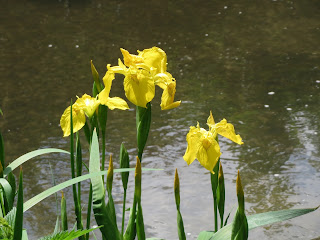Salvia patens is tuberous, and easily lifted for overwintering in a greenhouse. The more common varieties reach 30–60 cm (12–24 in) tall and wide, and are covered with hastate shaped mistletoe-green leaves. Inflorescences reach 15 to 30 cm (5.9 to 11.8 in) or longer, rising well above the leaves. 2.6 cm (1.0 in) pure blue flowers are spaced along the inflorescence, with a 1.3 cm (0.51 in) green calyx that adds to the attractiveness of the flowers.
The specific epithet patens means "spreading".
Salvia patens is frequently treated as an annual by gardeners due to its sensitivity to hard frost, with bedding plants often put out in spring. Varieties have been developed with colors ranging from white to lilac to various shades of blue. Seeds from the Netherlands have been available since the 1990s for rich colored and large flowered varieties.
The species and its cultivar 'Cambridge blue' have gained the Royal Horticultural Society's Award of Garden Merit.William Robinson praised the species in the 1933 edition of The English Flower Garden as, "doubtless, the most brilliant in cultivation, being surpassed by and equalled by few other [garden] flowers." A collecting trip to Mexico in 1991 led by James Compton discovered a 1.8 m (5.9 ft) tall variety with large deep blue flowers that is available as 'Guanajuato'.
 Eriophorum vaginatum L. (hare's-tail cottongrass, tussock cottongrass, sheathed cottonsedge) is a species of perennial herbaceous flowering plant in the sedge family Cyperaceae. It is native to bogs and other acidic wetlands throughout the Holarctic Kingdom. It is a 30–60 cm high tussock-forming plant with erect solitary spikelets.
Eriophorum vaginatum L. (hare's-tail cottongrass, tussock cottongrass, sheathed cottonsedge) is a species of perennial herbaceous flowering plant in the sedge family Cyperaceae. It is native to bogs and other acidic wetlands throughout the Holarctic Kingdom. It is a 30–60 cm high tussock-forming plant with erect solitary spikelets.
 E. vaginatum is a 30–60 cm high tussock-forming plant. The inflorescence is a dense, tufted cyme with erect solitary, multiflowered spikelets. It is rhizomatous, with leaves usually longer than the stem, and the fruit is an achene. Each individual tussock comprises 300–600 tillers, which contain two to three needle-like leaves enclosed in a sheath at the base. The density of tillers in a tussock depends both upon the diameter of the tussock (tiller density decreases as tussock diameter increases) and invasion by mosses and shrubs, factors which also affect tiller size and robustness of tiller production.
E. vaginatum is a 30–60 cm high tussock-forming plant. The inflorescence is a dense, tufted cyme with erect solitary, multiflowered spikelets. It is rhizomatous, with leaves usually longer than the stem, and the fruit is an achene. Each individual tussock comprises 300–600 tillers, which contain two to three needle-like leaves enclosed in a sheath at the base. The density of tillers in a tussock depends both upon the diameter of the tussock (tiller density decreases as tussock diameter increases) and invasion by mosses and shrubs, factors which also affect tiller size and robustness of tiller production.















































